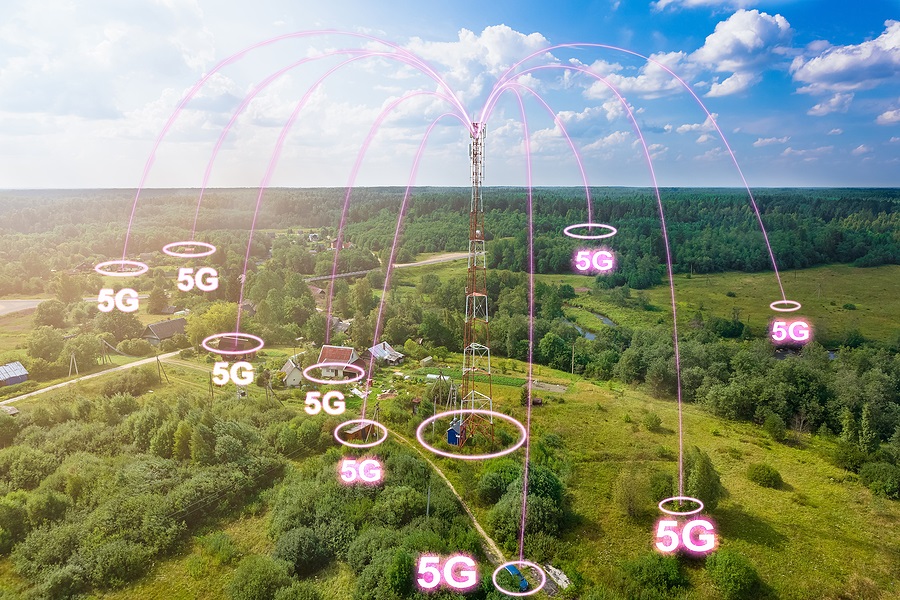WASHINGTON, June 22, 2021 /PRNewswire/ — The Platforms for Advanced Wireless Research (PAWR) program, funded by the National Science Foundation (NSF) and an industry consortium of 35 leading wireless companies, today announced ARA as the fourth testbed in a diverse portfolio of large-scale wireless research platforms located throughout the United States. Designated as ARA: Wireless Living Lab for Smart and Connected Rural Communities, the new platform in Central Iowa complements the technical specialties of earlier PAWR platforms, adding a focus on technologies for low-cost, high-speed rural broadband connectivity.
In addition to $7 million from NSF, the ARA platform has received another $1 million in financial support from the United States Department of Agriculture’s (USDA’s) National Institute of Food and Agriculture (NIFA). The funding will be augmented by in-kind contributions from the PAWR industry consortium to match the federal investment.
“I am thrilled to hear Iowa State has received this grant to help bolster broadband connectivity in rural areas,” said Rep. Randy Feenstra (IA-04). “This program reflects the importance of developing and utilizing public-private partnerships to spark innovation and expand broadband and precision agriculture capabilities, which will empower our producers to improve efficiency by taking a more targeted approach to farming practices. As the first and only PAWR testbed in the Midwest, I am excited to watch this project unfold – and I am hopeful it will lead to innovative solutions that will close the digital divide and improve the quality of life for rural Iowans and Americans.”
ARA will establish its wireless living lab across Iowa State University, the city of Ames, and surrounding farms and rural communities in Central Iowa. Creating a deeply programmable infrastructure, ARA will feature a wide range of wireless technologies as well as an application focus on precision agriculture in both crop and livestock farms.
“ARA enables research in end-to-end broadband infrastructures for rural and remote areas, and it features high-performance, programmable platforms in wireless access, wireless backhaul, and edge and cloud,” said Professor Hongwei Zhang, Principal Investigator for ARA. “By supporting fundamental communication services such as ultra-reliable, low-latency communications, ARA enables field research studies (e.g., tele-operations of vehicles or drones) that are of generic interest to rural and urban regions but are difficult to conduct in urban settings in early stages of the exploration.”
“Ericsson is excited to contribute our equipment and expertise to this groundbreaking rural innovation platform,” said Paul Challoner, Vice President of Network Solutions for Ericsson North America, a PAWR industry consortium partner. “ARA will help to redefine the research capabilities in rural America, in conjunction with PAWR and NSF, to develop technology to address the digital and mobility divides that currently exist in the U.S. The ARA platform will provide insights and technology advances needed to stimulate and support the economy of rural America.”
With the launch of the rural broadband platform, ARA joins three other PAWR testbeds: POWDER-RENEW in Salt Lake City, Utah; COSMOS in the West Harlem neighborhood of New York City; and AERPAW in the Research Triangle area of North Carolina. The PAWR program also features other resources and facilities including Colosseum, the world’s largest radiofrequency emulator, and OpenAirX-Labs (OAX), a neutral lab environment for the development and testing of a benchmark, open source 5G software stack.
The PAWR program is designed to accelerate the development and commercialization of promising technologies and applications, ensuring continued U.S. leadership in wireless communications while also preparing the emerging workforce for new job opportunities in the digital economy.
ARA Platform Details
ARA is based out of Iowa State University where a team of researchers including students will work in close collaboration with state, community, and industry partners. Select partners include the Iowa Communications Network (ICN), Iowa Department of Transportation (IDOT), Iowa Statewide Interoperable Communications System (ISICS), Iowa Regional Utilities Association (IRUA), Iowa Communications Alliance, city of Ames, Story County, local school districts, Meskwaki Tribal Nation, Woodland Farms, U.S. Cellular, Collins Aerospace, and John Deere. Researchers from the University of California, Irvine, Ohio State University, and International Computer Science Institute are also key members of the project team.
The ARA testbed will produce a heterogeneous network environment featuring a wide range of wireless technologies. For backhaul connectivity, ARA will create a multi-modal, high-capacity wireless mesh network including low Earth orbit (LEO) satellite links, a free-space optical (FSOC) platform, and long-distance millimeter wave (mmWave) and microwave point-to-point communications. In the radio access network (RAN), ARA will employ low-UHF massive MIMO (mMIMO) and other platforms to enable research across multiple frequencies including the TV white space (TVWS) band, CBRS band, and several others.
The ARA platform will feature software defined radios (SDRs) and programmable off-the-shelf equipment. This virtualized and programmable network will support research in areas such as bandwidth aggregation, channel bonding, and dynamic spectrum sharing, as well as resilient, high-throughput, and long-distance wireless backhaul and access, which are expected to lay the foundation for more affordable rural broadband service.
To learn more about ARA, visit www.arawireless.org.
For more information on the PAWR program, visit the PAWR website at www.advancedwireless.org.
About the PAWR Project Office (PPO)
The Platforms for Advanced Wireless Research Project Office (PPO) manages the $100 million public-private partnership and oversees the research platforms. The PPO is co-led by US Ignite and Northeastern University, and funded by the National Science Foundation and PAWR industry consortium. The PPO collaborates closely with the wireless research community, local communities, and industry, in part through the industry consortium, in the design, development, deployment, and initial operations of the research platforms.
About US Ignite
US Ignite is a high–tech nonprofit with a mission to accelerate the smart community movement. Our public-private partnership programs leverage advanced networking and data science to drive key outcomes for communities. Our work also enables new opportunities for wireless and IoT research designed to help narrow the gap between cutting–edge experimentation and scalable, real–world technology deployments.
About Northeastern University
Northeastern University is a global, experiential, and top–tier research university, with the world’s most innovative cooperative education program. Research in the College of Engineering looks at critical issues in materials, processes, systems, and infrastructure at every scale—nano to macro to global—grounded in a translational approach that integrates the values of fundamental and applied research to meet societal needs.
About the National Science Foundation
The National Science Foundation (NSF) propels the nation forward by advancing fundamental research in all fields of science and engineering. NSF supports research and people by providing facilities, instruments, and funding to support their ingenuity and sustain the U.S. as a global leader in research and innovation. With a fiscal year 2021 budget of $8.5 billion, NSF funds reach all 50 states through grants to nearly 2,000 colleges, universities, and institutions. Each year, NSF receives more than 40,000 competitive proposals and makes about 11,000 new awards. Those awards include support for cooperative research with industry, Arctic and Antarctic research and operations, and U.S. participation in international scientific efforts.
About the USDA’s National Institute of Food and Agriculture
USDA’s National Institute of Food and Agriculture invests in and advances agricultural research, education, and Extension across the nation to make transformative discoveries that solve societal challenges. NIFA supports initiatives that ensure the long-term viability of agriculture and applies an integrated approach to ensure that groundbreaking discoveries in agriculture-related sciences and technologies reach the people who can put them into practice. In FY2020, NIFA’s total investment was $1.95 billion.
CONTACT: PAWR Project Office, info@advancedwireless.org
SOURCE Platforms for Advanced Wireless Research (PAWR)

